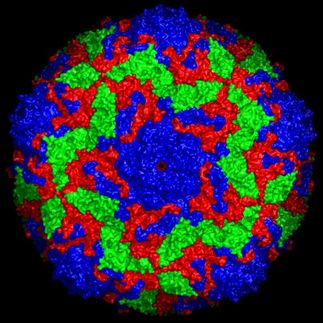Researchers snap giant virus in 3-D
Study demonstrates potential of future X-ray laser investigations
Using the world´s most powerful X-ray laser, an international team of researchers, including scientists from DESY, have produced a 3-D image of an intact, infectious virus. The experiment at the SLAC National Accelerator Laboratory in the U.S. reveals part of the inner structure of the Mimivirus, as the collaborative team led by Dr. Tomas Ekeberg from Uppsala University in Sweden report in the journal Physical Review Letters.

3-D reconstruction of a Mimivirus, based on an analysis of data obtained in an experiment at SLAC's LCLS that show the electron density of an intact Mimivirus. The blue regions represent the areas of highest density.
Uppsala University
The study using SLAC´s Linac Coherent Light Source (LCLS) demonstrates how the 3-D structure of many types of biological samples can be reconstructed from a series of X-ray laser snapshots. This technique holds great potential, also for the European XFEL, an X-ray Free-Electron Laser that is currently under construction between DESY in Hamburg and the neighbouring town of Schenefeld.
“Ever since I started in this field of X-ray laser research, this has always been the dream – to acquire 3-D images of real biological samples,” said Dr. Tomas Ekeberg, a biophysicist at Uppsala University in Sweden and lead author of the study. “This is fantastic – it´s a breakthrough in our research.”
The Mimivirus belongs to a curious class of giant viruses discovered just over a decade ago. With a diameter of 750 nanometers, including a hairy fur, Mimivirus is larger than some bacteria and it was misclassified as a bacterium until 2003. Subsequent discoveries have found other giant viruses, some of which are even larger. Mimivirus is also genetically complex, with nearly 1000 major genes compared to only a handful in the Aids virus HIV.
Scientists have been trying to determine the inner structure of these giant viruses to learn more about their origins: For example, did they borrow genes over time from the host organisms they infect, like amoebas? Did they precede cell-based life or devolve from cell-based organisms?
In the LCLS experiment, researchers sprayed a gas-propelled aerosol containing active Mimivirus samples in a thin stream into the X-ray laser beam, which scattered off the viruses and produced light patterns on a detector that were recorded as diffraction images. From these diffraction patterns, images of the individual virus particles can be reconstructed. Using sophisticated analysis software the scientists compiled hundreds of individual images from separate virus particles into a single 3-D portrait showing the general shape and inner features of an “average” Mimivirus.
Each image captured a projection of a separate virus particle at a random orientation, so the collection of images of viruses in different orientations provided a more complete, 3-D view. “Our study provides just a glimpse of the potential of future investigations of three-dimensional biological structures with X-ray lasers like the LCLS or the European XFEL”, said co-author Prof. Henry Chapman, DESY scientist from the Center for Free-Electron Laser Science CFEL in Hamburg.
While the technique used at LCLS did not provide high-resolution details of the internal virus structure in this demonstration study, it did confirm that its contents are lopsided, with an area that appears more densely concentrated. “We can see quite clearly that the inside of these viruses is not uniform,” Ekeberg said. This same general feature had also been seen before using an electron-based imaging technique with frozen samples. X-ray lasers like the LCLS and the future European XFEL allow studies of viruses and other biological samples in a more natural, intact state. According to the researchers, this technique shows promise for achieving sharper images that reveal more inner details in the future because of the uniquely intense, penetrating power of the X-rays.





























































